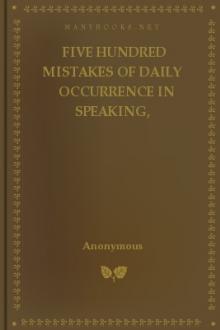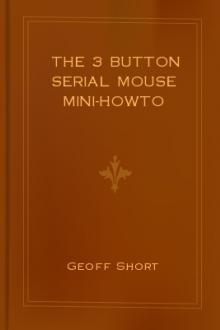The Elements of Drawing, John Ruskin [ebook reader with built in dictionary txt] 📗

- Author: John Ruskin
- Performer: -
Book online «The Elements of Drawing, John Ruskin [ebook reader with built in dictionary txt] 📗». Author John Ruskin
134. And here it may be noted in passing, that, if you enjoy the pursuit of analogies and types, and have any ingenuity of judgment in discerning them, you may always accurately ascertain what are the noble characters in a piece of painting by merely considering what are the noble characters of man in his association with his fellows. What grace of manner and refinement of habit are in society, grace of line and refinement of form are in the association of visible objects. What advantage or harm there may be in sharpness, ruggedness, or quaintness in the dealings or conversations of men; precisely that relative degree of advantage or harm there is in them as elements of pictorial composition. What power is in liberty or relaxation to strengthen or relieve human souls; that power precisely in the same relative degree, play and laxity of line have to strengthen or refresh the expression of a picture. And what goodness or greatness we can conceive to arise in companies of men, from chastity of thought, regularity of life, simplicity of custom, and balance of authority; precisely that kind of goodness and greatness may be given to a picture by the purity of its color, the severity of its forms, and the symmetry of its masses.
135. You need not be in the least afraid of pushing these analogies too far. They cannot be pushed too far; they are so precise and complete, that the farther you pursue them, the clearer, the more certain, the more useful you will find them. They will not fail you in one particular, or in any direction of inquiry. There is no moral vice, no moral virtue, which has not its precise prototype in the art of painting; so that you may at your will illustrate the moral habit by the art, or the art by the moral habit. Affection and discord, fretfulness, and quietness, feebleness and firmness, luxury and purity, pride and modesty, and all other such habits, and every conceivable modification and mingling of them, may be illustrated, with mathematical exactness, by conditions of line and color; and not merely these definable vices and virtues, but also every conceivable shade of human character and passion, from the righteous or unrighteous majesty of the king to the innocent or faultful simplicity of the shepherd boy.
136. The pursuit of this subject belongs properly, however, to the investigation of the higher branches of composition, matters which it would be quite useless to treat of in this book; and I only allude to them here, in order that you may understand how the utmost noblenesses of art are concerned in this minute work, to which I have set you in your beginning of it. For it is only by the closest attention, and the most noble execution, that it is possible to express these varieties of individual character, on which all excellence of portraiture depends, whether of masses of mankind, or of groups of leaves.
137. Now you will be able to understand, among other matters, wherein consists the excellence, and wherein the shortcoming, of the tree-drawing of Harding. It is excellent in so far as it fondly observes, with more truth than any other work of the kind, the great laws of growth and action in trees: it fails,—and observe, not in a minor, but in the principal point,—because it cannot rightly render any one individual detail or incident of foliage. And in this it fails, not from mere carelessness or incompletion, but of necessity; the true drawing of detail being for evermore impossible to a hand which has contracted a habit of execution. The noble draughtsman draws a leaf, and stops, and says calmly,—That leaf is of such and such a character; I will give him a friend who will entirely suit him: then he considers what his friend ought to be, and having determined, he draws his friend. This process may be as quick as lightning when the master is great—one of the sons of the giants; or it may be slow and timid: but the process is always gone through; no touch or form is ever added to another by a good painter without a mental determination and affirmation. But when the hand has got into a habit, leaf No. 1 necessitates leaf No. 2; you cannot stop, your hand is as a horse with the bit in its teeth; or rather is, for the time, a machine, throwing out leaves to order and pattern, all alike. You must stop that hand of yours, however painfully; make it understand that it is not to have its own way any more, that it shall never more slip from one touch to another without orders; otherwise it is not you who are the master, but your fingers. You may therefore study Harding's drawing, and take pleasure in it;[33] and you may properly admire the dexterity which applies the habit of the hand so well, and produces results on the whole so satisfactory: but you must never copy it; otherwise your progress will be at once arrested. The utmost you can ever hope to do would be a sketch in Harding's manner, but of far inferior dexterity; for he has given his life's toil to gain his dexterity, and you, I suppose, have other things to work at besides drawing. You would also incapacitate yourself from ever understanding what truly great work was, or what Nature was; but, by the earnest and complete study of facts, you will gradually come to understand the one and love the other more and more, whether you can draw well yourself or not.
138. I have yet to say a few words respecting the third law above stated, that of mystery; the law, namely, that nothing is ever seen perfectly, but only by fragments, and under various conditions of obscurity.[34] This last fact renders the visible objects of Nature complete as a type of the human nature. We have, observe, first, Subordination; secondly, Individuality; lastly, and this not the least essential character, Incomprehensibility; a perpetual lesson, in every serrated point and shining vein which escapes or deceives our sight among the forest leaves, how little we may hope to discern clearly, or judge justly, the rents and veins of the human heart; how much of all that is round us, in men's actions or spirits, which we at first think we understand, a closer and more loving watchfulness would show to be full of mystery, never to be either fathomed or withdrawn.
Fig. 26. Fig. 26.139. The expression of this final character in landscape has never been completely reached by any except Turner; nor can you hope to reach it at all until you have given much time to the practice of art. Only try always when you are sketching any object with a view to completion in light and shade, to draw only those parts of it which you really see definitely; preparing for the after development of the forms by chiaroscuro. It is this preparation by isolated touches for a future arrangement of superimposed light and shade which renders the etchings of the Liber Studiorum so inestimable as examples, and so peculiar. The character exists more or less in them exactly in proportion to the pains that Turner has taken. Thus the Æsacus and Hesperie was wrought out with the greatest possible care; and the principal branch on the near tree is etched as in Fig. 26. The work looks at first like a scholar's instead of a master's; but when the light and shade are added, every touch falls into its place, and a perfect expression of grace and complexity results. Nay, even before the light and shade are added, you ought to be able to see that these irregular and broken lines, especially where the expression is given of the way the stem loses itself in the leaves, are more true than the monotonous though graceful leaf-drawing which, before Turner's time, had been employed, even by the best masters, in their distant masses. Fig. 27 is sufficiently characteristic of the manner of the old wood-cuts after Titian; in which, you see, the leaves are too much of one shape, like bunches of fruit; and the boughs too completely seen, besides being somewhat soft and leathery in aspect, owing to the want of angles in their outline. By great men like Titian, this somewhat conventional structure was only given in haste to distant masses; and their exquisite delineation of the foreground, kept their conventionalism from degeneracy: but in the drawings of the Carracci and other derivative masters, the conventionalism prevails everywhere, and sinks gradually into scrawled work, like Fig. 28, about the worst which it is possible to get into the habit of using, though an ignorant person might perhaps suppose it more "free," and therefore better than Fig. 26. Note also, that in noble outline drawing, it does not follow that a bough is wrongly drawn, because it looks contracted unnaturally somewhere, as in Fig. 26, just above the foliage. Very often the muscular action which is to be expressed by the line runs into the middle of the branch, and the actual outline of the branch at that place may be dimly seen, or not at all; and it is then only by the future shade that its actual shape, or the cause of its disappearance, will be indicated.
Fig. 27. Fig. 27.140. One point more remains to be noted about trees, and I have done. In the minds of our ordinary water-color artists a distant tree seems only to be conceived as a flat green blot, grouping pleasantly with other masses, and giving cool color to the landscape, but differing no wise, in texture, from the blots of other shapes which these painters use to express stones, or water, or figures. But as soon as you have drawn trees carefully a little while, you will be impressed, and impressed more strongly the better you draw them, with the idea of their softness of surface. A distant tree is not a flat and even piece of color, but a more or less globular mass of a downy or bloomy texture, partly passing into a misty vagueness. I find, practically, this lovely softness of far-away trees the most difficult of all characters to reach, because it cannot be got by mere scratching or roughening the surface, but is always associated with such delicate expressions of form and growth as are only imitable by very careful drawing. The penknife passed lightly over this careful drawing will do a good deal; but you must accustom yourself, from the beginning, to aim much at this softness in the lines of the drawing itself, by crossing them delicately, and more or less effacing and confusing the edges. You must invent, according to the character of tree, various modes of execution adapted to express





Comments (0)